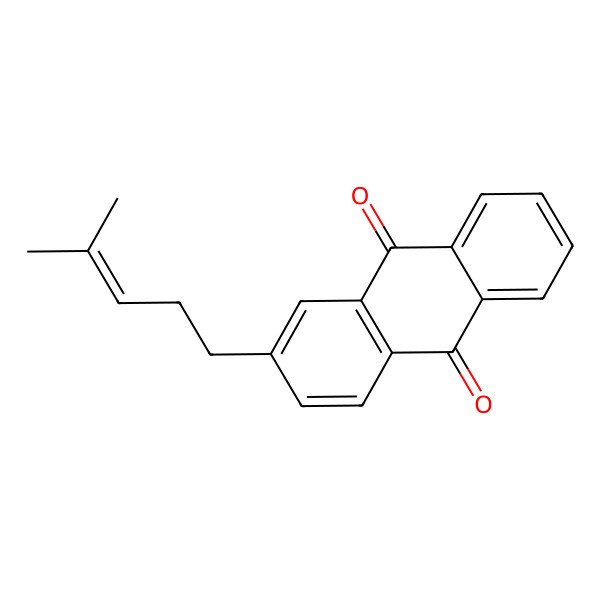2-(4-Methyl-3-pentenyl)anthraquinone
| Internal ID | 8fe7d5c8-e390-4984-b2a5-d63cffb4be0c |
| Taxonomy | Benzenoids > Anthracenes > Anthraquinones |
| IUPAC Name | 2-(4-methylpent-3-enyl)anthracene-9,10-dione |
| SMILES (Canonical) | CC(=CCCC1=CC2=C(C=C1)C(=O)C3=CC=CC=C3C2=O)C |
| SMILES (Isomeric) | CC(=CCCC1=CC2=C(C=C1)C(=O)C3=CC=CC=C3C2=O)C |
| InChI | InChI=1S/C20H18O2/c1-13(2)6-5-7-14-10-11-17-18(12-14)20(22)16-9-4-3-8-15(16)19(17)21/h3-4,6,8-12H,5,7H2,1-2H3 |
| InChI Key | NQVBCGTZRWHVSY-UHFFFAOYSA-N |
| Popularity | 2 references in papers |
| Molecular Formula | C20H18O2 |
| Molecular Weight | 290.40 g/mol |
| Exact Mass | 290.130679813 g/mol |
| Topological Polar Surface Area (TPSA) | 34.10 Ų |
| XlogP | 5.80 |
| HKP95YQ9XY |
| 71308-16-2 |
| UNII-HKP95YQ9XY |
| 2-(4-methylpent-3-enyl)anthracene-9,10-dione |
| EC 428-320-1 |
| NSC 248045 |
| NSC-248045 |
| NSC248045 |
| SCHEMBL2106464 |
| CHEMBL4797118 |
| There are more than 10 synonyms. If you wish to see them all click here. |

| Target | Value | Probability (raw) | Probability (%) |
|---|---|---|---|
| No predicted properties yet! | |||
Proven Targets:
| CHEMBL ID | UniProt ID | Name | Min activity | Assay type | Source |
|---|---|---|---|---|---|
| No proven targets yet! | |||||
Predicted Targets (via Super-PRED):
| CHEMBL ID | UniProt ID | Name | Probability | Model accuracy |
|---|---|---|---|---|
| CHEMBL2581 | P07339 | Cathepsin D | 99.54% | 98.95% |
| CHEMBL5619 | P27695 | DNA-(apurinic or apyrimidinic site) lyase | 93.92% | 91.11% |
| CHEMBL3401 | O75469 | Pregnane X receptor | 92.45% | 94.73% |
| CHEMBL3108638 | O15164 | Transcription intermediary factor 1-alpha | 92.19% | 95.56% |
| CHEMBL1951 | P21397 | Monoamine oxidase A | 89.39% | 91.49% |
| CHEMBL1293249 | Q13887 | Kruppel-like factor 5 | 88.31% | 86.33% |
| CHEMBL2535 | P11166 | Glucose transporter | 83.95% | 98.75% |
| CHEMBL4793 | Q86TI2 | Dipeptidyl peptidase IX | 82.72% | 96.95% |
| CHEMBL226 | P30542 | Adenosine A1 receptor | 82.25% | 95.93% |
| CHEMBL3060 | Q9Y345 | Glycine transporter 2 | 81.79% | 99.17% |
| CHEMBL3251 | P19838 | Nuclear factor NF-kappa-B p105 subunit | 80.13% | 96.09% |
Below are displayed all the plants proven (via scientific papers) to contain this
compound!
To see more specific details click the taxa you are interested in.
To see more specific details click the taxa you are interested in.
| Sesamum indicum |
| PubChem | 317256 |
| LOTUS | LTS0264358 |
| wikiData | Q82062184 |